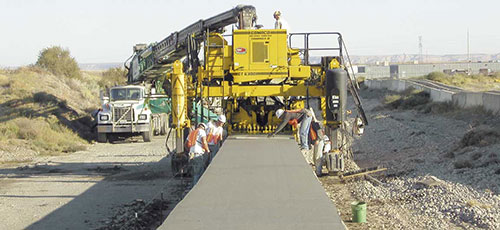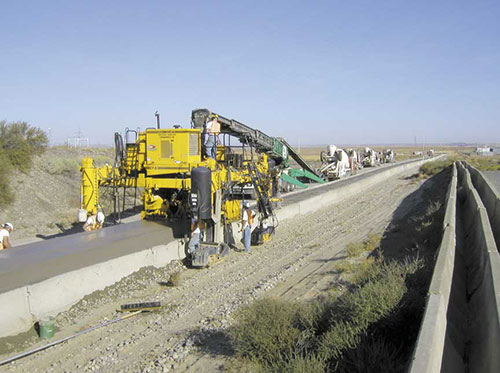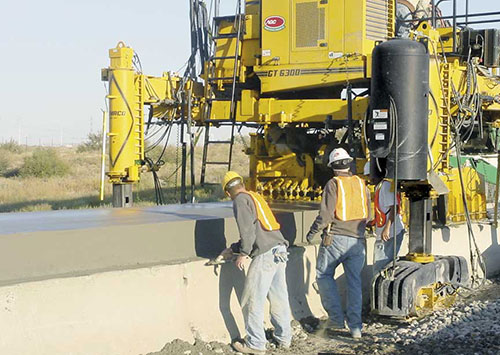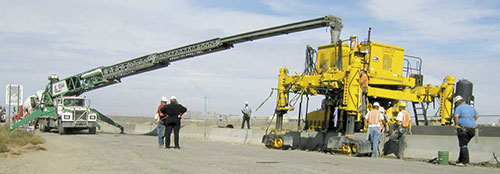GOMACO World Index --- GOMACO World 33.2 - September 2005
Concrete Strengthens Homeland Security
Poppoff Inc. slipformed a new top cap over existing barrier wall to help strengthen security around a nuclear facility in Richland, Washington.
Mike Poppoff, president of Poppoff Inc., decided in 2001 that he wanted to be more competitive in the construction of dairies. Up to that point, everything they did was handformed and his company just wasn’t staying competitive. He needed a concrete slipform paver.
“We just fully realized that if we wanted to play in that market, we had to get mechanized,” Poppoff explained. “We went to the World of Concrete show in 2001, looked at all the pavers, and it boiled down to the GOMACO GT-6300.”
Now, they’re able to slipform all of the concrete slabs and curbs for the wash and feed alleys and even put grooves in the slab behind the mold. The grooves provide traction for the cattle and keep them from slipping on the concrete surface.
“Instead of taking 60 days to complete our portion of the dairy work on projects, we do it in just ten,” Poppoff said.
Just recently, the company had a chance to try their hand at slipforming something totally unique. The Energy Northwest Hanford Nuclear Facility near Richland, Washington, needed some additional security measures taken to make it comply with the new Homeland Security laws. The plant had existing, preformed, Jersey-style barrier walls that surrounded the facility. Two barriers run side by side, ranging from six to seven feet (1.8 to 2.1 m) apart, and the gap between the two was filled with three inch (76 mm) round rock.
The new engineering regulations to make the existing barrier meet the criteria would include digging out six inches (152 mm) of the existing rock. Once that was done, a 20 inch (508 mm) thick by six feet (1.8 m) wide concrete cap would be formed over the top. All of the concrete work had to be completed within a very demanding time frame and project engineers weren’t confident that one contractor alone would be able to accomplish the project in time.
Poppoff Inc. and two other contractors were awarded the contract to cap a total of 21,500 feet (6553 m) of the barrier. Poppoff would be the only one of the three to slipform it.
“We went into this project with a lot of unknowns,” Poppoff said. “How would we get the GT-6300 on top of the existing barrier? How would we get concrete to it once it was up there? Did we have enough travel in the legs to reach that high? And finally, the height of all of the barriers varied. Would the machine be able to react quickly enough to those variances?”
To begin with, they took all four legs off their GT-6300 and rebolted them to the highest mounting setting. A crane was brought in and the GT-6300 was lifted over the existing barrier so it straddled the two walls. The concrete placing problem was solved by bringing in a Telebelt®, a placer with a telescopic belt conveyor. Poppoff felt it would be the best solution to handle the two inch (51 mm) slump, 4000 psi (27 MPa) concrete mix.
With most of their challenges solved, all that was left to do before starting the project was pass security checks and take special classes to allow them to work around a nuclear facility.
“The security was incredible,” Poppoff said. “It was interesting because the security people liked to come and watch the machine work, but it was rather intimidating to see someone standing there with an automatic weapon.”
The project’s tight deadline was always a constant concern, too. Poppoff knew that to complete the project in time, they needed to average 1200 feet (366 m) per day. Their project also increased within the first week when they ended up with a portion that had been previously awarded to a handforming contractor.
“We knew we had to average 600 yd3 (459 m3) a day and we needed to get the concrete up to the top of the mold at 46 inches (1168 mm) high and some times up to 60 inches (1524 mm) in order for it to feed properly. The Telebelt worked well for us there,” Poppoff said. “We exceeded our goal and ended up averaging just under 1300 feet (396 m) per day with a best day’s production of 1640 feet (500 m). It went very, very fast.”
Production was high and the GT-6300 was performing well in the challenging condition. Not only was the top of the mold 46 inches (1168 mm) high, the ground around the existing barrier that the tracks traveled on varied over 12 inches (305 mm). The barrier, itself, was old, and the height from one section to the next could vary up to three inches (76 mm).
Stringline for steering was set up on one side of the paver and Poppoff sensored off the top of the wall at the four corners of the machine to try to counteract the elevation changes.
“That’s how the barrier went and it was a challenge to make sure we blended those inaccuracies of what the existing barriers were,” Poppoff explained. “We didn’t know how the machine would react, but it met those quick changes in elevation and reacted very well.”
The top cap was floated and then broomed for finishing work. Control joints were cut every 40 feet (12.2 m). Also, when the barriers were seven feet (2.1 m) apart, a six inch (152 mm) piece was left on both sides and finishers sloped those areas for drainage. As an extra touch on the entire top cap, Poppoff added an 0.375 inch (10 mm) crown to keep water from standing on it.
This project was something completely new for Poppoff and his crew and they went into it facing a large amount of obstacles. Poppoff credits his crew and his GT-6300 for its success.
“This was a totally different kind of paving from our normal dairy work,” Poppoff said. “The challenge was how much everything varied and if the GT-6300 would react quickly enough to blend those changes. It performed very, very well, and we didn’t have a problem with the machine at all.”
Poppoff and his crew slipformed two of the three portions of the project, which was 14,000 feet (4267 m) of the top cap in 11 days, finishing the project ahead of schedule.
Subscribe to Receive GOMACO World Magazine



